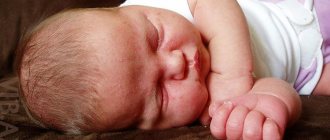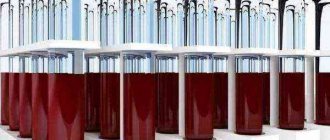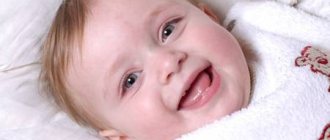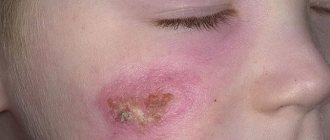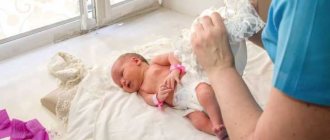Types of blisters and their descriptions with photos
Rashes on the body in the form of tubercles filled with liquid are called blisters or vesicles. As a rule, these are small cavity formations that are filled with lymph. The contents of the vesicles are transparent, mixed with pus or blood. The shape of the blister is most often a circle, but it can also be different. The color of the pimples can vary from pinkish to bright red. Vesicles are also white with a grayish tint. Some have an insect bite mark. Due to the release of histamine by the dermis, severe itching is felt at the site of the blister. When you press on the bubble, you can feel the density and texture of the formation, and pain occurs. Blisters in a child can be small in size (2-5 mm) and large (1-10 cm), with frequently located formations merging with each other. Types of watery pimples with explanations can be seen in the photo.
Blisters on the arms, legs, face and other localization of rashes
If the rash is localized on the hands and itches, this is usually a manifestation of an allergy to a local irritant, after which the vesicles quickly disappear. Small pimples that appear on the face or stomach may indicate a food allergy.
Watery blisters on the heels, feet, or balls of the feet may be caused by your child wearing ill-fitting shoes. Simply put, these are common calluses that cause pain and other discomfort. If you notice a callus on your baby's feet, you can cover it with a bactericidal plaster. Uncomfortable shoes need to be replaced, since calluses will haunt the baby constantly.
Also, rashes on the feet and between the toes may indicate the presence of a fungal skin infection. In addition to the legs, microsporia affects other parts of the body; it can appear on the arms, face, scalp, and torso. In these same areas, rashes from insect bites may occur.
With a viral illness, such as chickenpox, blisters appear throughout the body, including the head. Shingles most often appears on the child's torso. Thus, the location of blisters on a child’s body can be very diverse and depend on many reasons.
Types of rash
Recently, an article appeared in the British Journal of Dermatology in which Spanish scientists described dermatological problems manifested by coronavirus. The study involved about 400 people infected with coronavirus.
Rash on extremities similar to frostbite
The appearance of a rash on the legs and arms was observed in approximately 20% of cases. Patients often complained of itching and painful sensations when touched. In most cases, such a rash appears in young people who experience a mild form of the disease.
The rash usually appears later than other common symptoms and lasts about 2 weeks.
Blisters
In some patients (16%), very small blisters of the same size and shape appear on the stomach and back. Slightly less often, such blisters appear on the arms and legs (10%).
Blisters most often appear in patients aged 35-55 years and are accompanied by unbearable itching. This rash lasts an average of 10 days.
Maculopapular rash
It looks like small red bumps. In some cases, it may appear along with other common symptoms. Their duration is 8-10 days. It is the most dangerous and common type of rash due to coronavirus (48%).
Hives
The rash, similar to hives, resembles a large number of small bumps that are red or white and very itchy. Many people infected with Covid experienced such a rash on all parts of the body, including on the palms of their hands. Its duration is 7-9 days and is most often observed in patients with a severe form (20%).
Livedo
It is the main sign of tissue death and circulatory problems. It appears as a purple mesh pattern on the skin. Most often occurs in elderly patients with severe disease. This type of rash is very rare.
Diseases accompanied by the appearance of watery blisters on the body
In addition, acne in children occurs as a result of insect bites, and they itch (we recommend reading: how and what can you do to relieve itching from mosquito bites in a child?). Some types of diseases are presented in the table.
| Name | Localization of the rash | Characteristic symptoms |
| Streptoderma | Pink spots appear on the face, arms and legs. After a few days, the spots turn into large, irregularly shaped vesicles. | General malaise, poor appetite, weakness. |
| Enterovirus | In the first days of the disease, a rash in the form of small blisters may appear on the skin. | Hyperthermia, migraine, vomiting. Intoxication of the body occurs. The virus negatively affects all internal organs of the child. |
| Herpes | Vesicles appear in the nose or lips. | Itching and burning appear at the site of the blisters. The condition may be accompanied by hyperthermia. |
| Shingles (caused by the herpes virus) | Blistering rashes appear in one place (on the back, chest or abdomen), then can spread over all skin integuments. | The rash is accompanied by pain in the part of the body where it appeared. There may be an increase in regional lymph nodes and an increase in body temperature. |
| Chickenpox (caused by the herpes simplex virus) (we recommend reading: why are they not vaccinated against smallpox in Russia now?) | Vesicles appear on the face, head and trunk. Gradually the whole body becomes covered with blisters. | The patient has headache, hyperthermia, and photophobia. |
| Autoimmune disease (pemphigus) (we recommend reading: how is pemphigus treated in children?) | Bubbles form everywhere: in the mouth, on the arms and legs, on the back, and stomach. However, they are of different sizes. | The disease is quite rare, but at the same time dangerous (can cause death). In this immune disease, the body fights against its own healthy cells. |
| Scabies | Vesicles are located between the fingers and on the elbows. Then, as the scabies mite advances, they spread throughout the skin. | The patient suffers from severe itching, especially at night, when the female forms passages under the skin and lays eggs. |
| Molluscum contagiosum (we recommend reading: treatment of molluscum contagiosum in children with photos) | At the site of infection, small bubbles with a black dot and a small depression are localized. When such a pimple is squeezed, the infection spreads further. | As a rule, the disease goes away on its own, but lasts several months. It does not pose a health hazard, except for visible defects on the skin. |
| Dropsy | Depending on which organ in the body has failed, dropsy is localized in the peritoneum, on the feet, chest, knee, or groin. | The skin swells, swelling occurs, severe thirst, and shortness of breath. Requires differential diagnosis, therefore, when identifying the first signs of dropsy, you need to go to the hospital. |
Possible complications and consequences of poor-quality treatment
With timely treatment, the blistering rash on the child’s skin disappears completely without consequences for his body. Complications may occur if:
- a secondary bacterial or viral infection has occurred (to prevent this from happening, do not squeeze out or tear off the vesicles);
- the parents did not pay enough attention to the rash that appeared on the baby’s skin and did not consult a doctor (serious allergic reactions, including Quincke’s edema or anaphylactic shock, are possible).
What to do if a rash appears on your back?
If any rash appears on the child’s skin, parents should definitely show the baby to the doctor. There is no need to delay this! Many infectious pathologies develop rapidly. It is important to note that specific skin diseases will be treated by a pediatric dermatologist.
To establish a diagnosis, a whole complex of advanced diagnostics is required. All children, regardless of age, undergo a general blood and urine test.
The appearance of characteristic abnormalities in these tests will indicate the presence of a viral or bacterial infection in the child’s body. According to indications, bacteriological studies are also carried out. They allow you to identify specific infectious agents directly on the skin.
To prevent the appearance of various rashes on the skin, it is very important to follow all basic hygiene principles. Regular skin care should be carried out daily using cosmetics and hygiene products approved for use in children.
Strengthening the immune system is also an important task in maintaining healthy skin in the baby. All children with chronic diseases of internal organs must undergo timely medical examination.
A rash in childhood is usually harmless; its cause most often can be allergies or infectious diseases. To find out which rash poses a real threat to a child’s life and when you need to quickly seek medical help, see below.
- Rash
- On the face
- On the body
- On the stomach
- On the back
- On the neck
- On the buttocks
- On foot
No comments Popular In order <textarea class=”textarea_comment” placeholder=”Write a comment…”> Submit Information is provided for reference purposes. Do not self-medicate. At the first symptoms of the disease, consult a doctor.
Types of rashes and locations on the child’s body
The rash occurs due to various reasons. It occurs with allergic reactions, infectious diseases, improper skin care, poisoning of various etiologies, insect bites, penetration of parasites into the body, mechanical stress, fungal infections, allergies. Depending on the cause of occurrence, there are different types of rashes on the body:
- spots of red, pink or white;
- pimples with clear liquid inside;
- pus-filled blisters or pustules;
- subcutaneous bumps;
- dry flaky spots;
- small bumps or papules;
- blue or red stars resembling subcutaneous hemorrhages.
Acne can be accompanied by itching, flaking and inflammation. In some cases, the skin at the site of the rash begins to crack and peel. In babies, pimples and blisters appear on the legs, arms, fingers, back, stomach, neck, face, butt (we recommend reading: why do white pimples appear on a child’s hands?). The location of the rash depends on the cause that caused it and the severity of the disease.
Streptoderma
- Nature of the rash: purulent spots or blisters up to 10 centimeters. The rash causes burning and itching.
- Localization: first on the face, then spread throughout the body.
- Additional symptoms: intoxication of the body, temperature up to 38-39 degrees, lymphadenitis.
- Treatment: antibacterial ointments, antibiotics, antipyretic drugs, hypoallergenic diet, treatment of the rash with brilliant green, boric alcohol.
Enterovirus
- Nature of the rash: blistering rash with clear liquid.
- Localization: on different parts of the body and mucous membranes.
- Additional symptoms: headache, nausea, vomiting, fever.
- Treatment: immunomodulators, antibiotics, drugs aimed at eliminating symptoms.
Pemphigus
- Character of the rash: transparent watery blisters with a red rim.
- Localization: at the beginning of the disease - in the oral cavity, then - arms, legs, abdomen.
- Additional symptoms: weakness, elevated body temperature.
- Treatment: antiviral drugs, glucocorticosteroids, antihistamines, antipyretic drugs.
Felinosis
- Character of the rash: blisters with a small crust. Appear at the site of infection.
- Localization: at the site of cat scratches.
- Additional symptoms: inflammation of the lymph nodes, intoxication of the body.
- Treatment: anti-inflammatory and antibacterial agents, antiallergic drugs.
Watery pimples can be caused by parasite infestation. The blistering rash on the stomach, feet and between the fingers and toes is caused by the scabies mite. The rash is very itchy, especially at night. The blisters turn into pink spots a few days after they appear. The disease is treated with external agents (for example, benzyl benzoate ointment) and antihistamines.
Foot fungus can appear as small, watery blisters on the feet and heels. A fungal infection can enter the body when visiting public swimming pools or the gym. It is often accompanied by itching and flaking of the skin. An infection on the leg is treated with antifungal ointments and gels, and sometimes tablets are used.
Treatment of rash in a child
Treatment for the rash begins after the doctor has determined the diagnosis. The main recommendation: do not cover skin lesions with a dye, such as brilliant green. This may make diagnosis difficult.
Treatment is divided into two types: with medications and folk remedies. Drug therapy occurs only as prescribed by a doctor, and natural methods are suitable as recommendations in the form of additional treatment.
Drug treatment
Methods of drug therapy:
- To eliminate allergy manifestations, the initial solution is to limit contact with the irritant and eliminate the allergen product. Then you need to take an antihistamine to relieve symptoms - itching, swelling, redness. Loratadine and Fenistil drops are usually prescribed. The dosage depends on the patient's age.
- Most often, chickenpox does not require special therapy. Zelenka is suitable for applying to areas of rashes.
- Rubella and measles require symptomatic treatment. The doctor may prescribe antipyretics (Nurofen), immunomodulators (Anaferon, Viferon, Kagocel). Measles is more severe and sometimes requires hospital observation.
- Infection with internal parasites, in addition to taking antiparasitic drugs (Piperazine), will require taking sorbents (Enterosgel, Polysorb) and a laxative (Duphalac). Helminthiasis detected in children under 2 years of age can only be treated under medical supervision.
- Scabies can be treated well with benzyl benzoate or sulfur ointment. Before application, the affected areas should be thoroughly cleaned with soap and water. An antihistamine is prescribed to relieve itching.
- A bacterial rash can be treated with antibiotics. For small children under 3 years of age, syrup products are recommended: Augmentin, Zinnat, Amoxiclav. In the case of severe cases or serious illnesses, treatment occurs in a hospital with possible surgical intervention to remove abscesses, such as boils. After which the affected areas are treated with antibacterial ointments.
- Insect bites (bees, wasps, mosquitoes) require antihistamines to relieve swelling and itching. The bite site should be treated with an antiseptic, or better yet, brilliant green to prevent purulent formations.
- Ringworm and other similar manifestations are treated with antifungal ointments, for example Terbix, Lamisil, Exoderil. Age should be taken into account. Usually the dosage of the active substance in the ointment is reduced. Up to 12 years of age, fungal manifestations are treated locally to avoid unwanted side effects.
Self-treatment is possible only if there is a clear understanding of the cause of the skin formation and the uncomplicated course of the disease. These include: heat rash, diaper allergy, washing powder, mild diathesis to a known product, mosquito bite.
Traditional methods
When treating with natural methods, parents should not forget that the skin of children is much more delicate than that of an adult. Therefore, some products may not be suitable for children.
Some safe recipes:
- Baths and lotions with the addition of chamomile and celandine decoctions. For a bath, brew a glass of the product with a liter of boiling water and wait 30 minutes. Strain and add to the bath. Doctors recommend bathing children in this liquid for prickly heat, pustules, and some other skin diseases. Lotions made from decoctions of these medicinal herbs are also good. You can also use calendula.
- Rubbing with aloe juice. It is necessary to squeeze the liquid out of the cut leaf of the plant and gently wipe the rash areas.
- The manifestation of allergies is well alleviated by nettle infusion. Can be used by children from 3 years old. You need to brew 2 tbsp. l. means a glass of boiling water. Leave for an hour. Strain and give the child two spoons as a drink before meals.
- Dandelion pulp. It will alleviate the condition of children who have food allergies. Grind a bunch of freshly picked dandelion leaves and flowers in a blender. Then add five times more water. You can take a tablespoon.
Often, a rash on the body of children is a manifestation of an allergy or heat rash. But sometimes rashes on the baby’s stomach and back can signal a serious internal illness. Therefore, contacting a pediatrician is mandatory.
Self-medication can lead to serious complications. Experts recommend strictly following the instructions of the doctor and the medicine. If skin formations do not go away and the little patient’s condition worsens, it is necessary to urgently call an ambulance.
Non-infectious rashes
- Small watery pimples in newborns and infants are caused by prickly heat. It occurs as a result of overheating and improper care of the baby's skin. At older ages, this phenomenon occurs less frequently. Miliaria is eliminated with the help of drying agents (decoctions of medicinal plants, powders, ointments).
- Allergic blistering rash is accompanied by swelling, itching, redness and peeling of the skin. The disease can be caused by food, household chemicals, cosmetics and medications. A distinctive feature of an allergic rash is that it disappears after the cause of the rash is eliminated. Allergies are treated with antihistamines.
- Hives on a child’s body is one of the types of allergic reactions of the body. It appears as white, watery blisters that resemble insect bites. The rash is localized in different parts of the body. Its appearance can also be caused by nervous shock, a reaction to a blood transfusion, or contact with chemical vapors.
- Half of newborns are affected by erythema toxicum on the 2nd day of life. One of the elements of the disease is a watery blister with purulent contents. The reasons for this phenomenon are not fully understood. The neoplasm disappears on its own a few days after its appearance. It does not require additional treatment and does not cause complications.
- When the ducts of the sweat glands are blocked, small itchy blisters form. Blisters in a child are localized on the hands, feet, palms and fingertips (we recommend reading: why do blisters appear on a child’s palms and how to treat them?). In medicine, this phenomenon is known as dyshidrosis or eczema. Various factors lead to the development of the disease: mental and physical overload, nervous shock, immune disorders, allergies, diseases of the endocrine system.
Causes
A variety of reasons lead to the appearance of rashes on the buttocks of babies. An important criterion for the appearance of such elements is, first of all, the age of the child.
The reasons that contribute to the development of a rash on the butt in a newborn child may be completely different than in a schoolchild or teenager. The severity of the manifestation of unfavorable symptoms of rashes may vary and depend on the initial condition of the baby.
The baby’s small body is very vulnerable to the penetration of various infections. Quite often, they are what cause various rashes on the child’s buttocks.
Bacterial infections can lead to the appearance of various skin elements in the baby, inside of which there is a yellow or bloody fluid. staphylococcal or streptococcal flora leads to the development of such pustules on the skin . Anaerobic microbes cause these forms of the disease much less frequently.
The appearance of a rash on a child’s bottom may indicate simple irritation. This can also happen to a completely healthy baby when wearing the wrong clothes.
In infants, this situation occurs when wearing diapers for a long time . Contact dermatitis in this case is characterized by the appearance of a rash on the buttocks and groin. This condition is quite unpleasant for the baby and can cause severe discomfort in him, as well as a change in his usual behavior.
Babies with skin rashes become more capricious. They can constantly change their position in the crib.
As a rule, contact dermatitis is accompanied by severe itching. This leads to the baby starting to scratch the damaged areas of the skin. This situation is extremely unfavorable, since the child can introduce a secondary bacterial infection into the scratching area, which leads to suppuration and the appearance of various pustules on the skin.
Allergic pathologies cause rashes to appear on the skin of babies quite often. In infants, the appearance of various rashes on the bottom, as a rule, results from the introduction of new food products into their diet in the form of complementary foods. The baby may have an individual hypersensitivity to some of these food components, which contributes to the development of an allergic reaction.
In children aged 2-3 years, allergies usually occur when sweets and chocolate are included in the diet. A fairly common cause of an allergic reaction can be the consumption of honey and various bee products.
The use of inappropriate cosmetics for children is also a very common cause of various rashes appearing on a child’s buttocks and legs. This rash is usually very itchy. Mothers usually notice this sign during daily hygiene procedures.
Older children may notice these symptoms on their own. Causes leading to the appearance of a rash include some childhood infections. These diseases are accompanied by fever, as well as many other unfavorable symptoms.
The high incidence of such infections occurs mainly in organized groups. Most of them are transmitted by airborne droplets, which causes significant morbidity.
Chickenpox, rubella, and measles are accompanied by the appearance of various rashes on the baby’s skin. These diseases lead to the child’s general well-being being greatly impaired.
The mood of a sick child can change quite quickly. Within a few minutes, after the baby cries, he regains his old smile and good mood.
The course of childhood infections is usually moderate , but ends with complete recovery.
Atopic dermatitis
Atopic dermatitis is the most common cause of rash in babies. Localization of the rashes is the back, shoulders, butt and stomach of the child. This happens due to exposure to allergens of various origins (chemical, plant or animal). Excessive dry skin also contributes to the appearance of rashes.
In children, atopic dermatitis can occur due to the use of low-quality children's cosmetics, which are used by parents for hygiene procedures. A rash on a baby's bottom and back indicates that diapers are not suitable for the baby.
Allergic reaction of the body
Babies have allergic reactions to medications and foods, so food and medications are carefully chosen for them.
The allergy manifests itself as redness on the stomach and back. The rash looks like small blisters or pimples of pink color. Also, allergies may cause large pink spots to appear. If a rash appears on the lower back of a baby, then most likely it is an allergy to diapers or heat rash.
Dermatological diseases in children
The cause of red spots that look like blisters can be scabies. The disease is caused by a special parasite. If left untreated, it will spread throughout all the folds of the body.
It is very difficult to notice the parasite. Sometimes you can see black dots under the skin.
Sweating
Occurs mainly in the youngest children. The rashes are white or red. Localization - back. Their appearance is provoked by excessive insulation of the child in sufficiently warm clothes. A small rash on a child’s back is also miliaria.
Chicken pox
Chicken pox is an infectious disease. Localization – back and other parts of the child’s body. The disease has an incubation period. It occurs most easily at a young age.
Rubella
Another infectious disease. Children without a single vaccination against it are at risk. A red rash on a child's back indicates that the baby has rubella.
Vesiculopustulosis
Vesiculopustulosis is a bacterial infection. The rashes look like blisters containing purulent contents. It is treated primarily with antibiotics.
Scabies
- The penetration of scabies mites into the skin leaves typical manifestations on it - flaky pink spots (a consequence of inflammation), on which traces of penetration are visible.
- The disease causes severe itching and irritation.
- There is a danger of infection when scratching. You can become infected through contact with a sick person. Therefore, the affected areas are very different. More often the arms, less often the back and stomach.
Lichen
- Pathology, which is provoked by the penetration of microsporum into the epidermis, as well as trichophytons.
- Fungal rashes take the form of spots with peeling, having a clear border.
- After cleansing the baby's skin, light spots remain.
- Children infected with lichen experience severe itching and can cause a secondary infection when scratching.
Meningitis
- The type of rash depends on the type of pathogen.
- The child's torso becomes covered with small hyperemic spots.
- Skin formations do not cause pain or itch.
- After a certain time, the symptoms increase and the temperature rises.
- Meningitis is characterized by photophobia and lethargy.
- If such a rash and symptoms are detected, urgent hospitalization is necessary - sudden death is likely.
Insect bites
- Household ticks, bedbugs that live in furniture and linen can bite a child. Bites leave marks on the stomach, back, and limbs in the form of a small red rash.
- The skin of children prone to allergic reactions reacts more often.
- Bites from larger insects (bees, wasps, mosquitoes) are more noticeable as pink, itchy lumps that increase in size, are painful and can cause an allergy attack.
Measles
Measles is a common disease among preschool children. Children who have not had measles and are not vaccinated against it fall into the high-risk zone.
Water pimples as a result of external influences
Watery blisters on various parts of a child's skin may appear as a result of a burn. A distinctive feature of such formations is that they appear in places of direct contact with the irritant. The area of damage and severity depend on the type of burn.
Thermal burn
Burns are divided into the following types:
- Sunny. They appear after prolonged exposure to the sun on uncovered areas of the skin. The bubbles burst a few days after they appear. May be accompanied by fever and itching.
- Thermal. They are a consequence of skin contact with hot surfaces. A sharp pain is felt at the burn sites.
- Chemical. Occurs when a person is exposed to toxic substances. Symptoms include: pain at the site of the lesion, swelling, painful shock, large watery blisters. Contact with poisonous gases and radiation can cause intoxication of the entire body.
- Burns from plants. Blisters appear after a person touches a plant (for example, nettle, hogweed, castor bean, kupena berries, foxglove leaves, datura).
If your child wears uncomfortable shoes, he may develop calluses and blisters on his feet. They appear in places where intense friction occurs. To prevent blisters, it is necessary to choose the right shoes for children.
Other causes of rash
In adolescence, the formation of a rash with purulent contents is caused by hormonal changes in the body. For the same reason, newborns develop milia, which disappear over time. Teenage girls sometimes develop watery blisters on the arms, legs, and bikini area due to mechanical hair removal. Other causes of the rash also include:
- insect bites;
- long-term use of medications;
- hypothermia;
- nervous disorders (neurodermatitis);
- dysfunction of internal secretion organs;
- hormonal disorders;
- diseases of the body's functional systems;
- metabolic disease.
Many parents confuse water pimples with a disease that has a similar name - dropsy. However, this disease is not classified as a skin pathology. Dropsy is expressed as swelling due to excessive accumulation of fluid that does not leave the body on its own. The cause of the disease is a disruption of the lymphatic system.
Preventive measures
It is impossible to predict the appearance of rashes in children. However, you can reduce their chances of occurrence to a minimum. Strengthening the immune system and timely preventive vaccinations will help avoid many infectious diseases.
Children should be explained as early as possible that they cannot eat or drink from someone else’s dishes, carry things that are not their own, or eat one piece of candy “for two.” Children's shoes and clothing should be made from natural materials, appropriate for age and weather conditions. The sun has a detrimental effect on many pathogenic microorganisms, but children should take sunbathing in doses.
If a rash appears on a child’s body, you should consult a specialist as soon as possible. The contents of the blisters cannot be squeezed out; it is necessary to supervise that the child does not scratch the pimples. If you suspect an infectious nature of the rash, you need to limit the patient’s communication with others.
Priority measures after detection
Red cheeks in a baby - why they turn red and peel
Treatment of any kind of rash should begin with consulting a doctor to accurately determine the nature of the rash.
You can only treat heat rash and known allergies yourself.
On a note. Self-medication can lead to complications. Do not squeeze, rip off or smear elements of the rash with alcohol-containing compounds. Doing this can lead to additional infection.
Child hygiene rules
The most important way to prevent many diseases is to observe the rules of personal hygiene yourself and teach children to follow them:
- bathe babies regularly;
- change clothes and bedding in a timely manner;
- iron all children's things;
- use hypoallergenic washing powder from the first months of a child’s life;
- monitor your diet;
- undergo medical examinations in a timely manner;
- take a walk in the fresh air every day.
If you pay close attention to your child's health, you can avoid many problems.
Which doctor should I contact?
The disease can be a dangerous disease. The appearance of harmless pimples can signal a serious infection. If, in addition to rashes, the baby has a fever and other alarming symptoms, then you should definitely consult a doctor.
Initially, you should show the baby to the pediatrician. He will conduct a series of studies and prescribe treatment. If necessary, the pediatrician will refer you to another specialist, for example, a dermatologist, allergist, or infectious disease specialist.
What not to do
In order not to aggravate the baby’s condition and not to introduce a new infection to the area of skin damage, parents should not self-medicate and also allow the child:
- squeeze out pus or burst blisters;
- itch;
- use ointments with bright pigmentation, they will complicate diagnosis.
It is strictly forbidden to scratch the sores
On a note. Measures can only be taken if the nature of the rash is known. If in doubt, you should consult a doctor.
